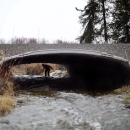States
South CarolinaThis project will replace an undersized culvert system on Horsepen Creek in South Carolina that is negatively affecting habitat for mussels like the endangered Carolina heelspliter. The project site is less than a mile upstream of designated critical habitat for the endangered mussels, so replacing the culverts will protect the mussels downstream and allow for upstream movement of mussels and their host fish. Additionally, the current culvert system creates human access and safety issues during high water events. They have caused frequent road closures during normal and high rain events, which are expected to intensify with climate change climate change
Climate change includes both global warming driven by human-induced emissions of greenhouse gases and the resulting large-scale shifts in weather patterns. Though there have been previous periods of climatic change, since the mid-20th century humans have had an unprecedented impact on Earth's climate system and caused change on a global scale.
Learn more about climate change . This project will increase flood resiliency, reduce road closures, and improve emergency vehicle access to residents.
Project Quick Facts:
| Project Status | In Development |
| Location | SC, Greenwood County |
| NFPP Project Funding | $400,000 |
| Restoration Techniques | Culvert replacement |
| Accomplishments | 12 Stream Miles Reopened |
| Partner Project Lead | Upper Savannah River Land Trust |
The National Fish Passage Program combines technical expertise with a track record of success.
Implemented primarily through the Service's Fish and Wildlife Conservation Offices, the National Fish Passage Program provides financial and technical assistance to partners across the country. Since 1999, the program has worked with over 2,000 local communities, Tribes, and private landowners to remove or bypass over 3,400 barriers to fish passage fish passage
Fish passage is the ability of fish or other aquatic species to move freely throughout their life to find food, reproduce, and complete their natural migration cycles. Millions of barriers to fish passage across the country are fragmenting habitat and leading to species declines. The U.S. Fish and Wildlife Service's National Fish Passage Program is working to reconnect watersheds to benefit both wildlife and people.
Learn more about fish passage and reopen access to over 61,000 miles of upstream habitat for fish and other animals. Staff have expertise in fish migration and biology as well as financial, engineering, and planning assistance to communities, Tribes, and landowners to help them remove barriers and restore rivers for the benefit both fish and people.
Fish passage project proposals can be initiated by any individual, organization, government, or agency. However, proposals must be submitted and completed in cooperation with a Fish and Wildlife Conservation Office. (Please note that fish passage projects being used for federal or state compensatory mitigation or required by existing federal or state regulatory programs are not eligible for funding through the National Fish Passage Program.)
CONTACT A FISH PASSAGE COORDINATOR IN YOUR AREA TO GET STARTED.

